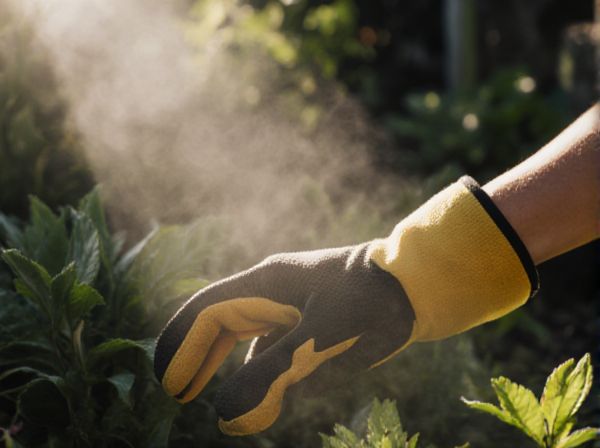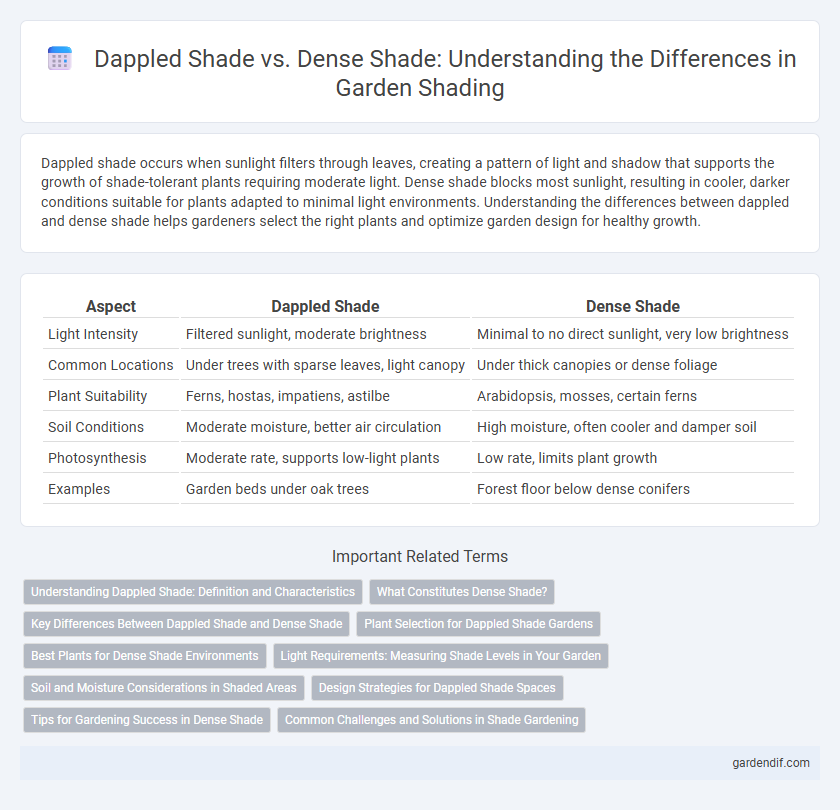
Dappled Shade vs Dense Shade Illustration
Dappled shade occurs when sunlight filters through leaves, creating a pattern of light and shadow that supports the growth of shade-tolerant plants requiring moderate light. Dense shade blocks most sunlight, resulting in cooler, darker conditions suitable for plants adapted to minimal light environments. Understanding the differences between dappled and dense shade helps gardeners select the right plants and optimize garden design for healthy growth.
Table of Comparison
| Aspect | Dappled Shade | Dense Shade |
|---|---|---|
| Light Intensity | Filtered sunlight, moderate brightness | Minimal to no direct sunlight, very low brightness |
| Common Locations | Under trees with sparse leaves, light canopy | Under thick canopies or dense foliage |
| Plant Suitability | Ferns, hostas, impatiens, astilbe | Arabidopsis, mosses, certain ferns |
| Soil Conditions | Moderate moisture, better air circulation | High moisture, often cooler and damper soil |
| Photosynthesis | Moderate rate, supports low-light plants | Low rate, limits plant growth |
| Examples | Garden beds under oak trees | Forest floor below dense conifers |
Understanding Dappled Shade: Definition and Characteristics
Dappled shade occurs when sunlight filters through the leaves of trees, creating a pattern of light and shadow that supports the growth of shade-tolerant plants. This type of shade typically features intermittent, gentle sunlight ideal for species like ferns, hostas, and astilbes, which thrive in indirect light. Understanding the subtle variations in light intensity and duration in dappled shade helps gardeners select suitable plants and optimize garden design.
What Constitutes Dense Shade?
Dense shade occurs when thick foliage, such as from mature trees with closely packed leaves, blocks most sunlight from reaching the ground, creating a consistently dark environment. This type of shade limits photosynthesis for understory plants due to minimal light penetration compared to dappled shade, where scattered sunlight filters through gaps in leaves. Dense shade is characterized by lower light intensity, cooler temperatures, and higher moisture retention under the canopy.
Key Differences Between Dappled Shade and Dense Shade
Dappled shade occurs when sunlight filters through the leaves of trees, creating a pattern of light and shadow on the ground, while dense shade results from thick foliage blocking nearly all direct sunlight. In dappled shade, plants receive intermittent sunlight that supports photosynthesis for shade-tolerant species, whereas dense shade restricts light to minimal levels, favoring only highly shade-adapted plants. Understanding these differences is critical for gardeners selecting suitable plants, as dappled shade allows for more diverse plant growth compared to the limited options in dense shade conditions.
Plant Selection for Dappled Shade Gardens
Dappled shade gardens thrive with plants that tolerate intermittent sunlight, such as ferns, hostas, and astilbes, which benefit from filtered light to maintain vibrant foliage and healthy growth. Unlike dense shade areas that require shade-loving plants like mosses and impatiens, dappled shade allows for a wider variety of species including flowering plants like bleeding hearts and hellebores. Selecting plants that adapt well to partial sunlight ensures optimal photosynthesis and enhances biodiversity in dappled shade garden environments.
Best Plants for Dense Shade Environments
Plants thriving in dense shade environments include hostas, ferns, and astilbes, which adapt well to low light conditions and maintain vibrant foliage. These species require minimal sunlight and prefer moist, well-drained soil, making them ideal for heavily shaded garden areas beneath dense tree canopies. Choosing shade-tolerant plants like hellebores and Solomon's seal ensures healthy growth and color in environments where direct sunlight is scarce.
Light Requirements: Measuring Shade Levels in Your Garden
Dappled shade allows filtered sunlight through a canopy, typically receiving 2 to 4 hours of indirect light daily, ideal for shade-tolerant plants requiring moderate light levels. Dense shade, with less than 2 hours of direct or indirect sunlight, occurs under thick tree canopies or structures, demanding plants adapted to low-light environments. Measuring light levels using a light meter or observing sun patterns helps gardeners select appropriate species for each shade type, ensuring optimal growth.
Soil and Moisture Considerations in Shaded Areas
Dappled shade allows more sunlight penetration, promoting well-drained soil with moderate moisture levels that support a wider range of plants. Dense shade results in cooler, moister soil conditions due to limited sunlight, often causing slower evaporation and potential soil compaction. Managing soil aeration and moisture retention is essential to prevent root rot and promote healthy plant growth in shaded environments.
Design Strategies for Dappled Shade Spaces
Dappled shade offers a unique design opportunity by allowing filtered sunlight to create dynamic patterns, making it ideal for planting shade-tolerant species like hostas, ferns, and astilbes that thrive in indirect light. Incorporating layered plantings with varying textures and heights enhances depth and visual interest, while paths made from natural materials such as bark or gravel complement the soft light environment. Strategic placement of seating areas in dappled shade zones maximizes comfort and connection with nature, promoting tranquil outdoor spaces that flourish without harsh sun exposure.
Tips for Gardening Success in Dense Shade
Gardening success in dense shade requires selecting shade-tolerant plants like ferns, hostas, and astilbes that thrive with minimal sunlight. Improving soil quality by adding organic matter ensures better nutrient retention and moisture control essential for growth in low-light areas. Installing reflective mulch or light-colored ground covers can help maximize available light, promoting healthier foliage development in dense shade conditions.
Common Challenges and Solutions in Shade Gardening
Dappled shade provides partial sunlight that supports a wider variety of shade-tolerant plants compared to dense shade, which limits photosynthesis due to minimal light penetration. Common challenges in dense shade include poor plant growth and increased susceptibility to fungal diseases, while dappled shade issues often involve uneven moisture levels and competition from tree roots. Solutions include selecting shade-adapted species like ferns or hostas for dense shade and improving soil drainage with organic mulch or amending soil to retain moisture in dappled shade environments.
Dappled Shade vs Dense Shade Infographic

 gardendif.com
gardendif.com